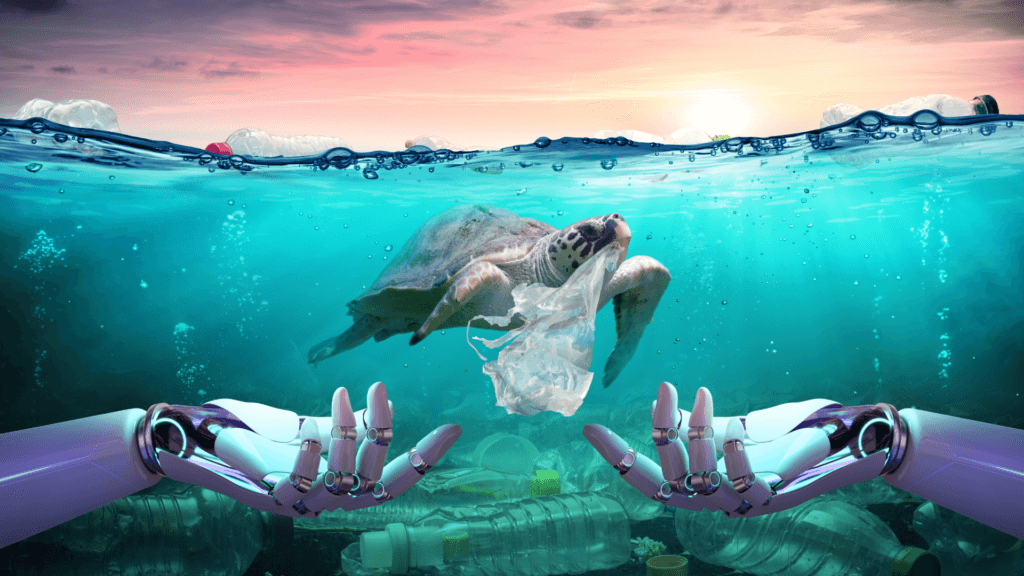How Can AI Help Clean up Plastics From Our Oceans and Waterways?

Technology has brought some key elements to bring significant changes in human lives and sustainability, and Artificial Intelligence (AI) is one of the latest and most amazing technology inclusions on the list, particularly as AI can help clean up our oceans and waterways.
AI can be defined as a technology that empowers machines to perform tasks in a manner that resembles applying human intelligence. AI can be useful to make manual tasks faster and more accurate, and take actions based on human logic and analytical thinking. According to Market.us, the global Artificial Intelligence market was valued to be worth USD 129.28 billion in 2022. From 2023 to 2032, it is estimated to reach USD 2,967.51 billion growing at a CAGR of 36.8%.
The application of AI has been primarily utilized in the digital platform to provide faster and more efficient responses to users. With the development of more advanced AI-enabled systems, various tools and techniques are now available that can provide facilities using intelligent actions and demonstrate abilities of decision making based on analytical thinking. Scientists and researchers are developing AI-based systems that help to get easy access to those areas that usually humans can’t reach and extract useful information for necessary investigation and analysis.
Using AI-based Systems to clean up Oceans & Waterways
The menace of plastic pollution is severely affecting the oceans as most of the plastic waste, which is non-biodegradable, goes to the ocean causing pollution and threatening the survival of marine species. It is necessary to identify the types, location, and amount of plastic waste in the ocean accurately and arrange cleaning up without arming the marine creatures. Scientists are working on innovative tools and techniques that utilize Artificial Intelligence (AI) in a variety of ways to investigate, understand and protect the oceans from plastic pollution. Identifying minute plastic wastes on the water surface and advanced underwater monitoring systems are some of the ways where AI is creating solutions for the problems of plastic pollution affecting the oceans and marine lives. Advanced AI-based technology is helping us to create more intelligent and effective systems to detect and monitor plastic debris.
Related: Why Big Companies Should Invest in Sustainable and Innovative Plastic Alternatives?
Different Ways of Using AI
There are several ways AI can be used to identify, control and reduce plastic waste ending up in rivers and oceans. Some of the latest methods are mentioned as follows:
- The ocean cleanup solutions involve the application of AI-based tools that use bridge-mounted cameras to capture the image of floating objects to locate plastic debris. The autonomous collection unit is then positioned to collect the plastic for removal. The devices are equipped with sensors attached to collect data on winds and ocean currents. An algorithm helps to create simulations to show how the cleanup systems work through the ocean.
- The intelligent software combined with automated capturing of images creates a remote sensing approach to monitor the dynamic behavior of floating plastic debris more efficiently. The application of efficient GoPro cameras to ships enables operators to track the large area of the ocean surface to identify marine debris. Using the new AI object detection algorithm, this information is analyzed to determine the exact location of uneven plastic distribution and deploy cleanup activities. Such technology software companies will require more and more SaaS link building services to be able to compete in the very crowded software market.
- Artificial intelligence can be used in drone imaging applications which can take numerous aerial photos in short intervals that help in tracking and subsequent cleaning of plastic waste. The drone images can map the ocean surface to detect hot spots with more concentration of plastics. By identifying plastic hot spots in the ocean, the team can design the most suitable clean-up system. The drone imaging system can be used to monitor the habit of littering by tourists and other people on the seashore and generate necessary alerts to control the problem at the source.
- The satellite imaging system is used to monitor and detect the tiny objects floating on the ocean surface as well as the accumulation of debris in the sea bed. Satellite imagery can be used to provide data to AI systems to look for a high concentration of plastic in oceans. Using the infra-red imaging techniques and Ai-based tool, it becomes possible to analyze the images pixel by pixel to detect the tiny particles of plastic debris as small as 5 mm size.
- Highly customized and advanced AI systems can be configured to distinguish between plastic and natural marine life. This feature allows taking an efficient approach to cleaning the high volume of trash while keeping the marine creatures safe and secure.
- River monitoring is also important to avoid plastic waste flowing into the oceans. This process uses imaging and analyzing techniques applied by Ai-enabled tools and software to differentiate between plastic and organic materials. A solar-powered extractor or interceptor collects the plastic debris to keep the river water clean and free from contamination.
Conclusion
The solution to the plastic pollution problem in oceans and waterways requires a clear understanding of its dimensions and severity. The knowledge about the volume and types of plastic waste accumulated in the ocean is very important to take appropriate actions. The AI-based systems provide accurate and adequate information that determines the design of cleanup systems, the logistics of implementing the process, the methods for segregating plastic, and the cost involved. The AI–based innovative monitoring systems with robotic technologies are widely used to identify plastic waste in oceans and waterways and expedite actions for cleaning. Using AI based-systems to clean our oceans and waterways can be an excellent way to accelerate the circular economy.
—
Browse the I’m Plastic Free directory to discover plastic pollution solutions.


